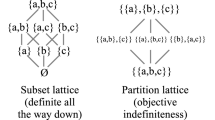Abstract
Modal interpretations constitute a particular approach to associating dynamical variables with physical systems in quantum mechanics. Given the “quantum logical” constraints that are typically adopted by such interpretations, only certain sets of variables can be taken to be simultaneously definite-valued, and only certain sets of values can be ascribed to these variables at a given time. Moreover, each allowable set of variables and values can be uniquely specified by a single “core” projector in the Hilbert space associated with the system. In general, the core projector can be one of several possibilities at a given time. In most previous modal interpretations, the different possible core projectors have formed an orthogonal set. This paper investigates the possibility of adopting a non-orthogonal set. It is demonstrated that such non-orthogonality is required if measurements for which the outcome can be predicted with probability 1 are to reveal the pre-existing value of the variable measured, an assumption which has traditionally constituted a strong motivation for the modal approach. The existing framework for modal interpretations is generalized to explicitly accommodate non-orthogonal core projectors.
Similar content being viewed by others
REFERENCES
A. Peres, Quantum Theory: Concepts and Methods (Kluwer Academic, Boston, 1995).
A. Einstein, B. Podolsky, and N. Rosen, “Can quantum-mechanical description of reality be considered complete?” Phys. Rev. 47, 777 (1935).
J. S. Bell, Speakable and Unspeakable in Quantum Mechanics (Cambridge University Press, Cambridge, 1993), Chap. 19.
J. Bub, Interpreting the Quantum World (Cambridge University Press, Cambridge, 1997).
This use of the term “modal interpretation” is consistent with that found in Clifton,(10) but differs from that of van Fraassen (6) for whom a modal interpretation need not be realist.We restrict the scope of the term in this paper for convenience.
B. van Fraassen, Quantum Mechanics: An Empiricist View (Oxford University Press, Oxford, 1991).
J. Bub and R. Clifton, “A uniqueness theorem for “no collapse” interpretations of quantum mechanics,” Stud. Hist. Phil. Mod. Phys. 27, 181 (1996).
G. Bacciagaluppi and M. Dickson, “Dynamics for modal interpretations,” Found. Phys. 29, 1165 (1999).
R. Healey, The Philosophy of Quantum Mechanics (Cambridge University Press, Cambridge, 1989).
R. Clifton, “The properties of modal interpretations of quantum mechanics,” Brit. J. Phil. Sci. 47, 371 (1996).
M. Dickson, “On the plurality of dynamics: Transition probabilities and modal interpretations,” in Healey and Hellman,(12) p. 160.
R. Healey and G. Hellman, eds., Quantum Measurement: Beyond Paradox (University of Minnesota Press, Minneapolis, 1997).
The classic article is G. Birkhoff and J. von Neumann, “The logic of quantum mechanics,” Ann. Math. 37, 823 (1936). For an overview, see K. Svozil, Quantum Logic (Springer, Singapore, 1998).
See, e.g., Bub,(4) p. 30.
R. Clifton, “Independently motivating the Kochen–Dieks modal interpretation of quantum mechanics,” Brit. Phil. Sci. 46, 33 (1995), p. 37.
R. W. Spekkens and J. E. Sipe, “A modal interpretation of quantum mechanics based on a principle of entropy minimization,” Found. Phys. 31, 10 (2001).
M. Redhead, Incompleteness, Nonlocality and Realism (Clarendon, Oxford, 1987).
D. Bohm and B. J. Hiley, The Undivided Universe: An Ontological Interpretation of Quantum Theory (Routledge, London, 1993).
See, e.g., Bohm;(18) C. Pagonis and R. Clifton, “Unremarkable contextualism: Dispositions in the Bohm theory,” Found. Phys. 25, 281 (1995). Bacciagalizppi and Hemmo(23). D. Dieks, “Preferred factorizations and consistent property attribution,” in G. Hellman and R. Healey,(12) p. 144. P. Vermaas, “The pros and cons of the Kochen–Dieks and the atomic modal interpretation,” in D. Dieks and P. Vermaas,(27) p. 103.
S. Kochen, A New interpretation of quantum mechanics, in P. Lahti and P. Mittelstaedt, eds., Symposium on the Foundations of Modern Physics (World Scientific, Singapore, 1985), p. 151.
D. Dieks, “The formalism of quantum theory: An objective description of reality?” Ann. Phys. 7, 174 (1988).
P. Vermaas and D. Dieks, “The modal interpretation of quantum mechanics and its generalization to density operators,” Found. Phys. 25, 145 (1995).
G. Bacciagaluppi and M. Hemmo, “State preparation in the modal interpretation,” in Healey and Hellman,(12) p. 95.
J. M. Jauch and C. Piron, “On the structure of quantal proposition systems,” Helv. Phys. Acta 43, 842 (1969).
P. Vermaas, “Expanding the property ascriptions in the modal interpretation of quantum mechanics,” in Healey and Hellman,(12) p. 115.
M. Dickson and R. Clifton, “Lorentz invariance in modal interpretations,” in D. Dieks and P. Vermaas,(27) p. 35.
D. Dieks and P. Vermaas, eds., The Modal Interpretation of Quantum Mechanics (Kluwer Academic, Boston, 1998).
J. Vink, “Quantum mechanics in terms of discrete beables,” Phys. Rev. A 48, 1808 (1993).
An analogous assumption about the initial conditions is made in Bohm' theory and has been the subject of some discussion. See, e.g., D. Dürr, S. Goldstein, and N. Zanghi, “Quantum equilibrium and the origin of absolute uncertainty,” J. Stat. Phys 67, 843 (1992); A. Valentini, “Signal-locality, uncertainty, and the subquantum ℋ-theorem. I,” Phys. Lett. A 156, 5 (1991); A. Valentini, “Signal-locality, uncertainty, and the subquantum H-theorem. II,” Phys. Lett. A 158, 1 (1991).
Author information
Authors and Affiliations
Rights and permissions
About this article
Cite this article
Spekkens, R.W., Sipe, J.E. Non-Orthogonal Core Projectors for Modal Interpretations of Quantum Mechanics. Foundations of Physics 31, 1403–1430 (2001). https://doi.org/10.1023/A:1012630512689
Issue Date:
DOI: https://doi.org/10.1023/A:1012630512689



